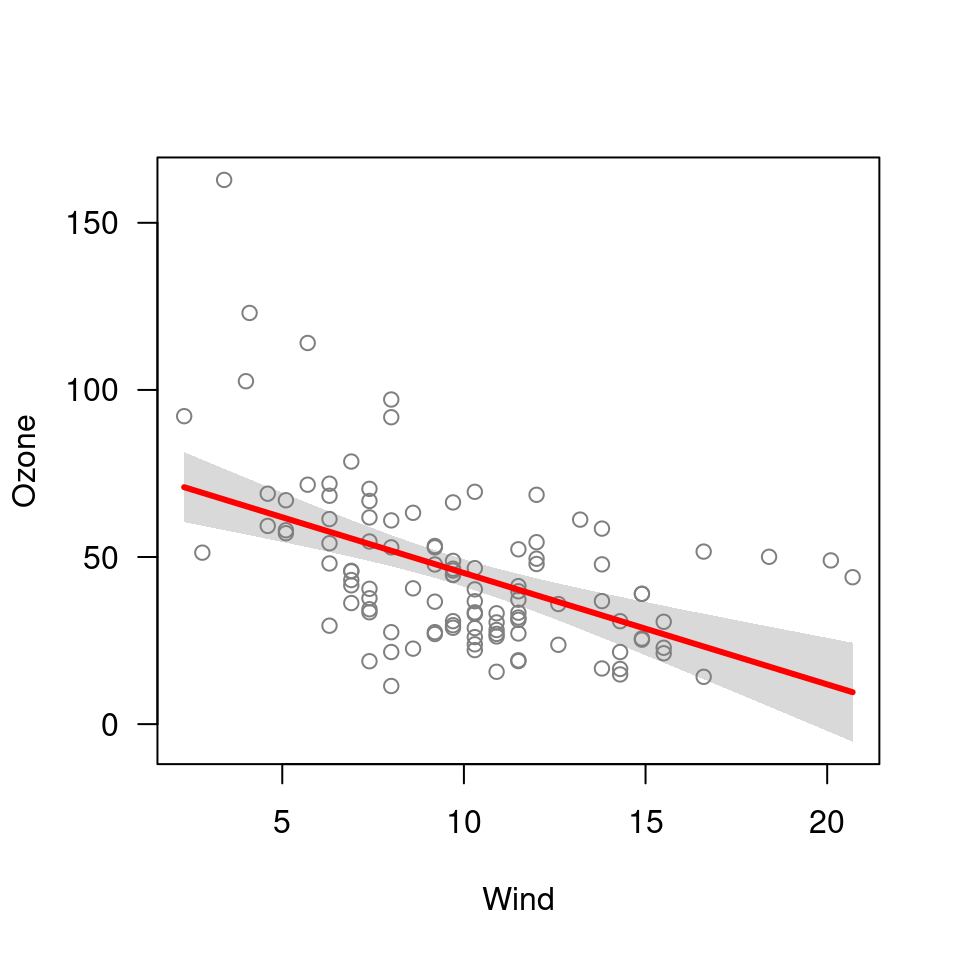A function for visualizing regression models quickly and easily. Default
plots contain a confidence band, prediction line, and partial residuals.
Factors, transformations, conditioning, interactions, and a variety of other
options are supported. The plot.visreg() function accepts a visreg
or visregList object as calculated by visreg() and creates the plot.
Usage
# S3 method for class 'visreg'
plot(
x,
overlay = FALSE,
print.cond = FALSE,
whitespace = 0.2,
partial = identical(x$meta$trans, I),
band = TRUE,
rug = ifelse(partial, 0, 2),
strip.names = is.numeric(x$fit[, x$meta$by]),
legend = TRUE,
top = c("line", "points"),
gg = FALSE,
line.par = NULL,
fill.par = NULL,
points.par = NULL,
...
)Arguments
- x
A
visregorvisregListobject; seevisreg().- overlay
By default, when
byis specified, separate panels are used to display each cross-section. Ifoverlay=TRUE, these cross-sections are overlaid on top of each other in a single plot.- print.cond
If
print.cond=TRUE, the explanatory variable values conditioned on in a conditional plot are printed to the console (default:FALSE). Ifprint.cond=TRUEandtype="contrast", the conditions will still be printed, but they have no bearing on the plot unless interactions are present.- whitespace
When
xvaris a factor,whitespacedetermines the amount of space in between factors on the x-axis. Default is 0.2, meaning that 20 percent of the horizontal axis is whitespace.- partial
If
partial=TRUE(the default), partial residuals are shown on the plot.- band
If
band=TRUE(the default), confidence bands are shown on the plot.- rug
By default, partial residuals are plotted. Alternatively, a
rug()may be plotted along the horizontal axis instead. Settingrug=TRUEturns off partial residuals by default; if one wants both to be plotted, bothrug=TRUEandpartial=TRUEneed to be specified. Two types of rug plots are available. Ifrug=1orrug=TRUE, then a basic rug is drawn on the bottom. Ifrug=2, then separate rugs are drawn on the top for observations with positive residuals and on the bottom for observations with negative residuals. Such plots are particularly useful in logistic regression (see examples).- strip.names
When
by=TRUE,strip.names=TRUEadds the name of thebyvariable to the strip at the top of each panel. Default isFALSEfor factors andTRUEfor numericbyvariables.strip.namescan also be a character vector, in which case it replaces the strip names altogether with values chosen by the user.- legend
For overlay plots, (
overlay=TRUE), should visreg create a legend? Iflegend=TRUE(the default), a legend is placed in the top margin.- top
By default, the fitted line is plotted on top of the partial residuals; usually this is preferable, but it does run the risk of obscuring certain residuals. To change this behavior and plot the partial residuals on top, specify
top='points'.- gg
By default (
gg=FALSE),visregwill use the lattice package to render the plot if multiple panels are required. Ifgg=TRUE, it will use the ggplot2 package instead, provided that it is installed.- line.par
List of parameters (see
par()) to pass tolines(...)orggplot2::geom_line()when lines are plotted.- fill.par
List of parameters (see
par()) to pass topolygon(...)orggplot2::geom_polygon()when shaded confidence regions are plotted.- points.par
List of parameters (
par()) to pass topoints(...)orggplot2::geom_point()when partial residuals are plotted.- ...
Graphical parameters can be passed to the function to customize the plots. If
by=TRUE, lattice parameters can be passed, such aslayout(see examples below).
References
Breheny P and Burchett W. (2017) Visualization of regression models using visreg. R Journal, 9: 56-71. doi:10.32614/RJ-2017-046
